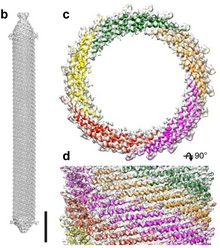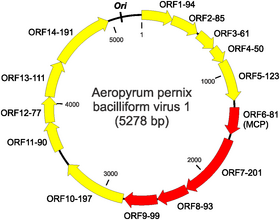Clavaviridae
| Clavaviridae | ||||||||||||||||
|---|---|---|---|---|---|---|---|---|---|---|---|---|---|---|---|---|
 Aeropyrum pernix bacilliform virus 1 (APBV1) | ||||||||||||||||
| Systematik | ||||||||||||||||
| ||||||||||||||||
| Taxonomische Merkmale | ||||||||||||||||
| ||||||||||||||||
| Wissenschaftlicher Name | ||||||||||||||||
| Clavaviridae | ||||||||||||||||
| Links | ||||||||||||||||
|
Clavaviridae ist die Bezeichnung für eine Familie Viren mit ringförmig geschlossenem (zirkulärem) Doppelstrang-DNA-Genom. Ihre natürlichen Wirte gehören zu den Archaeen. Die Familie wurde erstmals 2010 von dem Team um D. Prangishvili beschrieben.[2] Es gibt derzeit (Mitte März 2021) nur eine einzige vom International Committee on Taxonomy of Viruses (ICTV) bestätigte Gattung in dieser Familie, Clavavirus. Innerhalb dieser Gattung wurde bis dahin ebenfalls nur eine einzige Art beschrieben: Aeropyrum pernix bacilliform virus 1 (APBV1).[3]
Der Name leitet sich vom lateinischen Wort clava für Stock ab, was eine Bezugnahme auf das stäbchenförmige Aussehen der Virusteilchen ist.[4]
Beschreibung

Die Vironen (Viruspartikel) sind stäbchenförmig und haben eine Länge von 14 nm bei einem Durchmesser von 15,8 nm.[2][5] Ein Ende ist spitz und das andere leicht abgerundet. Die Struktur der APBV1-Virionen wurde mittels Kryoelektronenmikroskopie mit nahezu atomarer Auflösung aufgeklärt und zeigt, wie das helikale Virion aus einem alpha-helikalen Hauptkapsidprotein (en. major capsid protein, MCP) mit einer für diese Familie spezifischen Faltung aufgebaut ist.[5] Die Virionen sind hoch thermostabil und bleiben nach Inkubation bei 100 °C für 3 h infektiös.

Das Genom ist unsegmentiert (monopartit) und besteht aus einem zirkulären, doppelsträngigen DNA-Molekül (dsDNA) mit einer Länge von 5,3 kbp (Kilobasenpaaren). Es integriert sich nicht in das Wirtsgenom. Das Genom enthält 14 offene Leserahmen (en. open reading frames, ORFs), von denen bei Entdeckung keiner eine Ähnlichkeit mit anderen Gen-Sequenzen in öffentlichen Datenbanken aufwies.[4]
Die Infektion mit Claviviren führt nicht zur Lyse der Wirtszelle.
Systematik

Die Systematik der Familie nach ICTV ist mtr Stand Mai 2024 wie folgt:[6][7]
Familie Clavaviridae
- Gattung Clavavirus
Weblinks
Weiterführende Literatur
- Mart Krupovic, Emmanuelle R. J. Quemin, Dennis H. Bamford, Patrick Forterre, David Prangishvili: Unification of the globally distributed spindle-shaped viruses of the Archaea. In: Journal of Virology. 88. Jahrgang, Nr. 4, 2014, ResearchGate:259320195, S. 2354–2358, doi:10.1128/JVI.02941-13, PMID 24335300, PMC 3911535 (freier Volltext) – (englisch).
- Fengbin Wang, Virginija Cvirkaite-Krupovic, Matthijn Vos, Leticia C. Beltran, Mark A. B. Kreutzberger, Jean-Marie Winter, Zhangli Su, Jun Liu, Stefan Schouten, Mart Krupovic, Edward H. Egelman: Spindle-shaped archaeal viruses evolved from rod-shaped ancestors to package a larger genome. In:
- Biophysical Journal, Band 121, Nr. 3, Februar 2022, S. 148a-149a; doi:10.1016/j.bpj.2021.11.1983, ResearchGate:358561680 (englisch).
- Cell, Band 185, Nr. 8, 14. April 2022, S. 1297-1307.e11; doi:10.1016/j.cell.2022.02.019, PMID 35325592, PMC 9018610 (freier Volltext), HAL:03620791, Epub 23. März 2022 (englisch).
Einzelnachweise
- ↑ a b c d e f ICTV:ICTV Master Species List 2019.v1 ( des vom 2. August 2022 im Internet Archive) Info: Der Archivlink wurde automatisch eingesetzt und noch nicht geprüft. Bitte prüfe Original- und Archivlink gemäß Anleitung und entferne dann diesen Hinweis., New MSL including all taxa updates since the 2018b release, March 2020 (MSL #35)
- ↑ a b Tomohiro Mochizuki, T. Yoshida, R. Tanaka, Patrick Forterre, Y. Sako, David Prangishvili: Diversity of viruses of the hyperthermophilic archaeal genus Aeropyrum, and isolation of the Aeropyrum pernix bacilliform virus 1, APBV1, the first representative of the family Clavaviridae. In: Virology. 402. Jahrgang, Nr. 2, 2010, S. 347–354, doi:10.1016/j.virol.2010.03.046, PMID 20430412 (englisch).
- ↑ David Prangishvili, Tomohiro Mochizuki, Ying Liu, Mart Krupovic, ICTV Report Consortium: ICTV Virus Taxonomy Profile: Clavaviridae. In: Journal of General Virology. 2019, doi:10.1099/jgv.0.001295, PMID 31271351 (englisch).
- ↑ a b SIB: Claviviridae, auf: ViralZone (Expasy)
- ↑ a b D. Ptchelkine, A. Gillum, Tomohiro Mochizuki, S. Lucas-Staat, Ying Liu, Mart Krupovic, S. E. V. Phillips, D. Prangishvili, J. T. Huiskonen: Unique architecture of thermophilic archaeal virus APBV1 and its genome packaging. In: Nature Communications. 8. Jahrgang, Nr. 1, 10. November 2017, S. 1436, doi:10.1038/s41467-017-01668-0, PMID 29127347, PMC 5681674 (freier Volltext) – (englisch).
- ↑ ICTV: Taxonomy Browser.
- ↑ ICTV: Virus Metadata Resource (VMR).
- ↑ NCBI: Clavaviridae
Auf dieser Seite verwendete Medien
Autor/Urheber: ViralZone, SIB Swiss Institute of Bioinformatics, Philippe Le Mercier et al., Lizenz: CC BY 4.0
Schemazeichnung eines Virions der Gattung Clavavirus (Fam. Clavaviridae)
Autor/Urheber: David Prangishvili, Tomohiro Mochizuki, Ying Liu and Mart Krupovic. Reproduced with permission from Ptchelkine et al., 2017., Lizenz: CC BY-SA 4.0
Claviviridae. Electron micrograph of virions of Aeropyrum pernix bacilliform virus 1 (APBV1). Virions imbedded in vitreous ice. Scale bar, 10 nm. Reproduced with permission from Ptchelkine et al., 2017.
Autor/Urheber: David Prangishvili, Tomohiro Mochizuki, Ying Liu and Mart Krupovic. Reproduced with permission from Ptchelkine et al., 2017., Lizenz: CC BY-SA 4.0
Claviviridae. 3D reconstruction of the virion structure of Aeropyrum pernix bacilliform virus 1 (APBV1). (b) 3D model of the virion shown from the side; scale bar, 10 nm. Top (c) and side (d) view of APBV1 map (transparent surface) and model of the major capsid protein VP1. VP1 subunits related by C5 symmetry are colored in red, yellow, green, orange, and magenta. Reproduced with permission from Ptchelkine et al., 2017.
Autor/Urheber: David Prangishvili, Tomohiro Mochizuki, Ying Liu and Mart Krupovic. Reproduced with permission from Ptchelkine et al., 2017., Lizenz: CC BY-SA 4.0
Clavaviridae. Genome map of Aeropyrum pernix bacilliform virus 1. Each ORF is designated with two numbers; the first number is the order starting from the first ORF after the putative ori, and the second reflects the number of amino acids in the encoded proteins. Red arrows indicate genes encoding virion proteins. MCP- major capsid protein.



